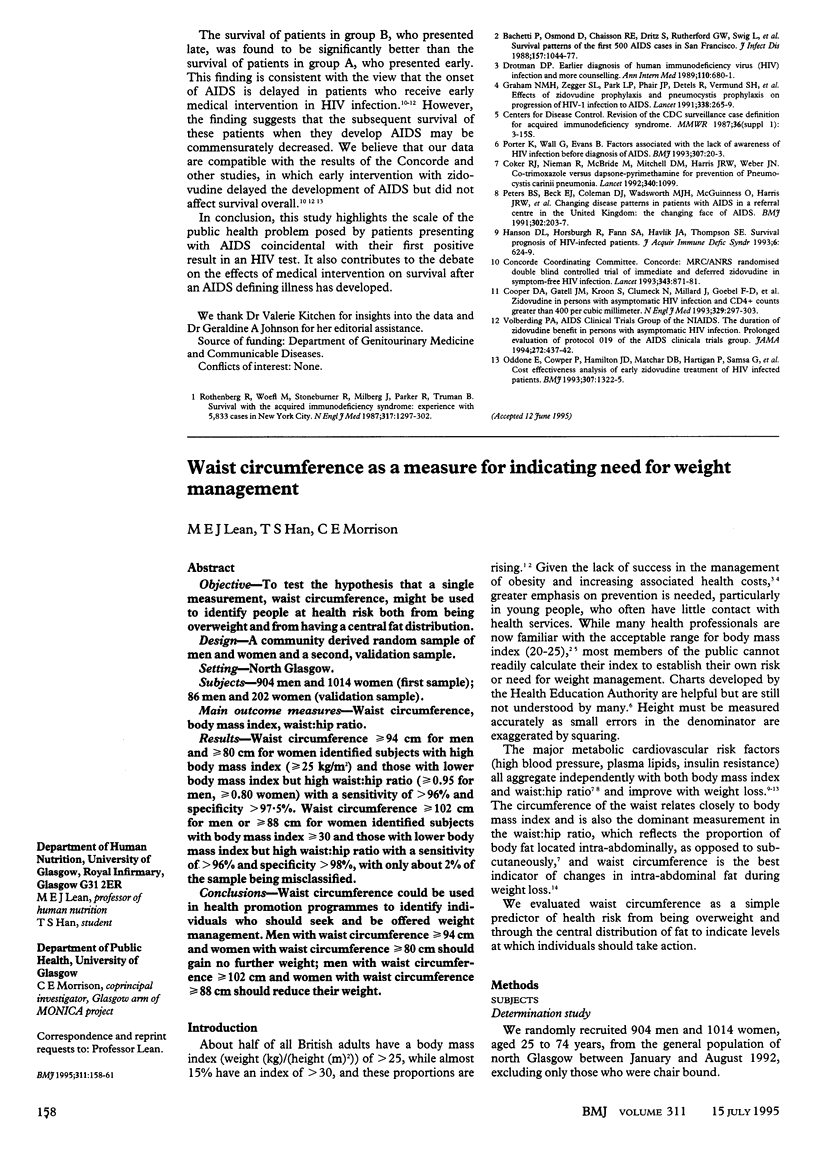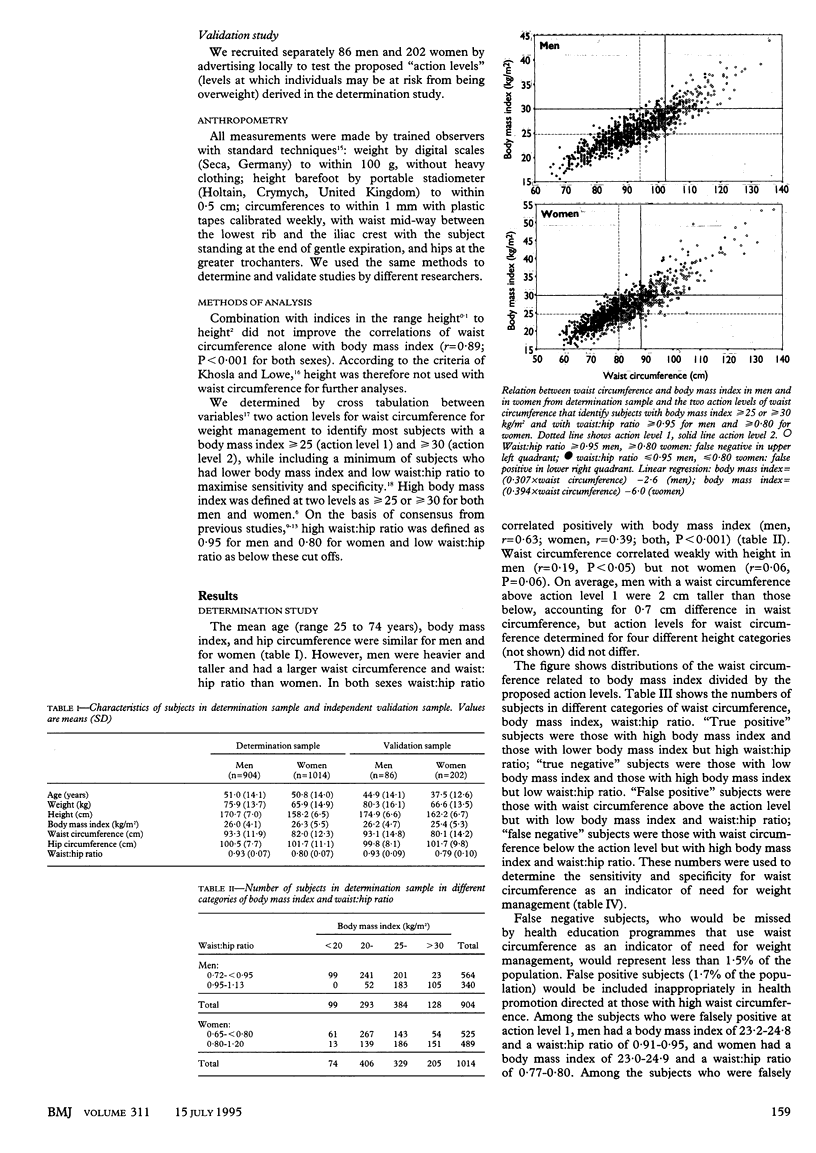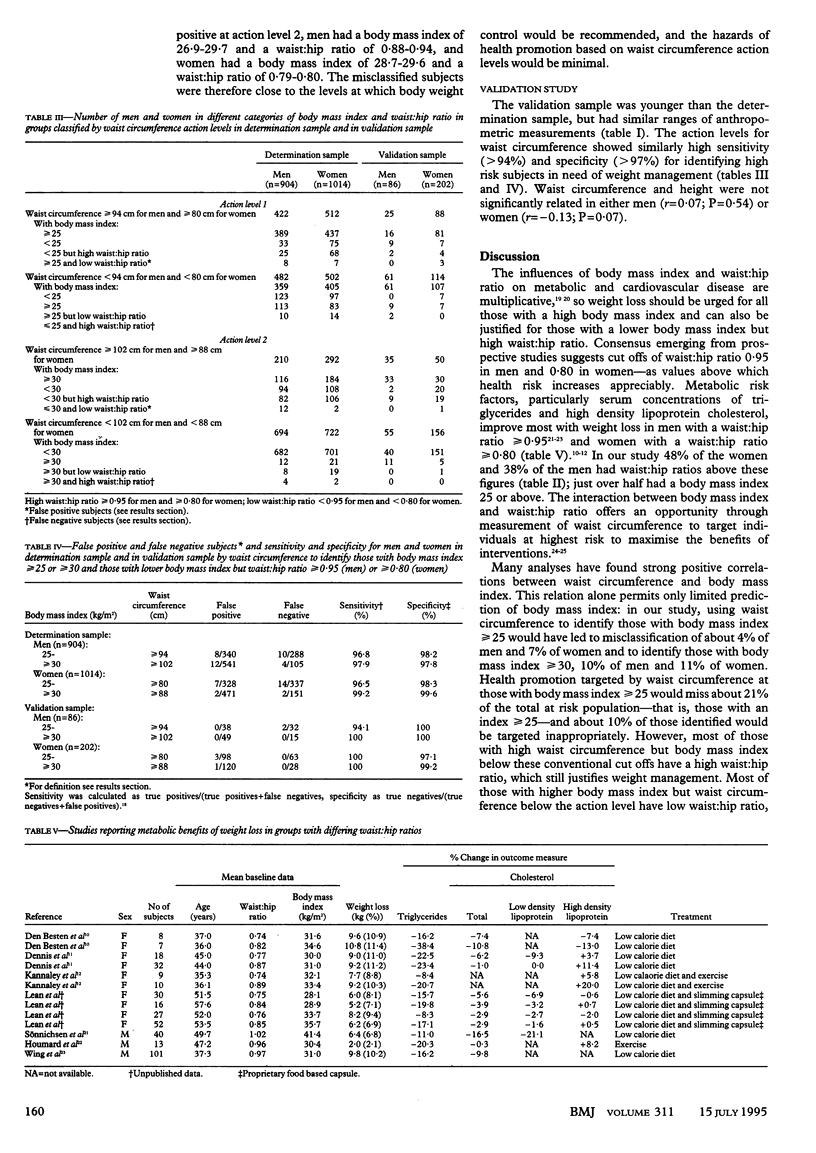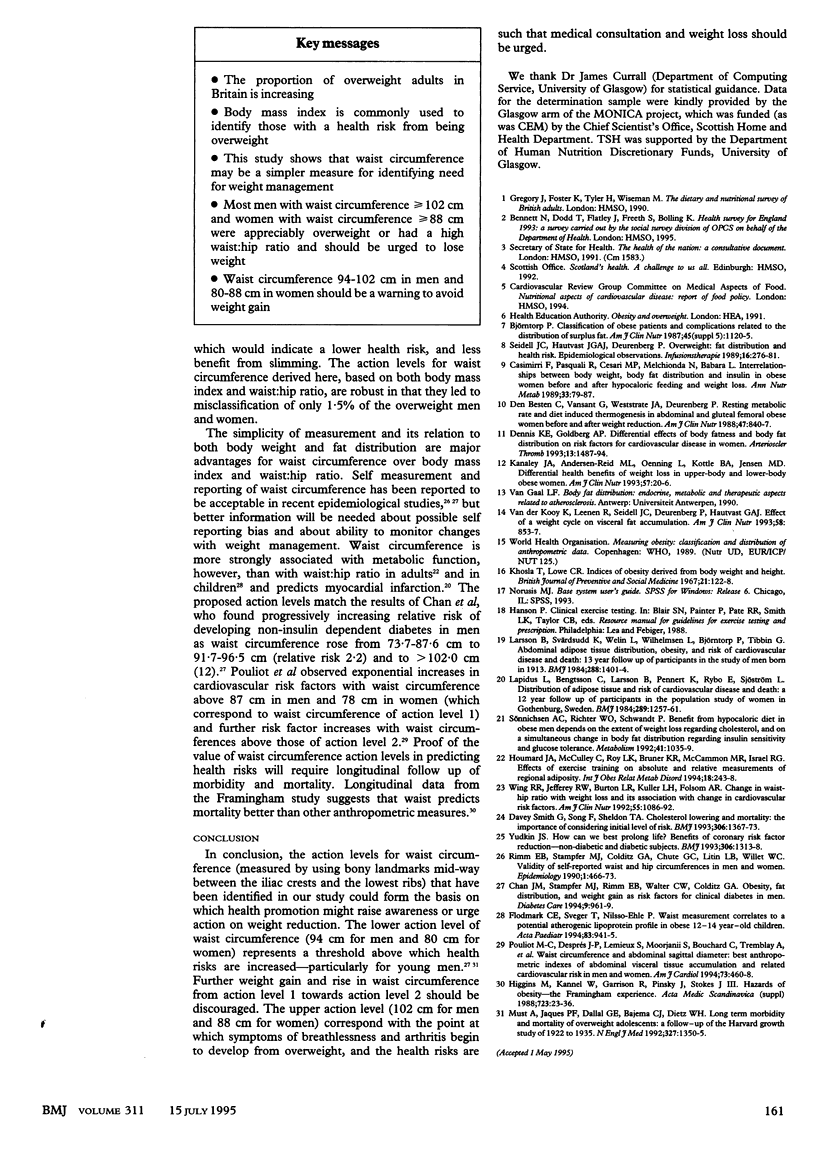Abstract
OBJECTIVE--To test the hypothesis that a single measurement, waist circumference, might be used to identify people at health risk both from being overweight and from having a central fat distribution. DESIGN--A community derived random sample of men and women and a second, validation sample. SETTING--North Glasgow. SUBJECT--904 men and 1014 women (first sample); 86 men and 202 women (validation sample). MAIN OUTCOME MEASURES--Waist circumference, body mass index, waist:hip ratio. RESULTS--Waist circumference > or = 94 cm for men and > or = 80 cm for women identified subjects with high body mass index (> or = 25 kg/m2) and those with lower body mass index but high waist:hip ratio (> or = 0.95 for men, > or = 0.80 women) with a sensitivity of > 96% and specificity > 97.5%. Waist circumference > or = 102 cm for men or > or = 88 cm for women identified subjects with body mass index > or = 30 and those with lower body mass index but high waist:hip ratio with a sensitivity of > 96% and specificity > 98%, with only about 2% of the sample being misclassified. CONCLUSIONS--Waist circumference could be used in health promotion programmes to identify individuals who should seek and be offered weight management. Men with waist circumference > or = 94 cm and women with waist circumference > or = 80 cm should gain no further weight; men with waist circumference > or = 102 cm and women with waist circumference > or = 88 cm should reduce their weight.
Full text
PDF



Selected References
These references are in PubMed. This may not be the complete list of references from this article.
- Casimirri F., Pasquali R., Cesari M. P., Melchionda N., Barbara L. Interrelationships between body weight, body fat distribution and insulin in obese women before and after hypocaloric feeding and weight loss. Ann Nutr Metab. 1989;33(2):79–87. doi: 10.1159/000177524. [DOI] [PubMed] [Google Scholar]
- Chan J. M., Rimm E. B., Colditz G. A., Stampfer M. J., Willett W. C. Obesity, fat distribution, and weight gain as risk factors for clinical diabetes in men. Diabetes Care. 1994 Sep;17(9):961–969. doi: 10.2337/diacare.17.9.961. [DOI] [PubMed] [Google Scholar]
- Dennis K. E., Goldberg A. P. Differential effects of body fatness and body fat distribution on risk factor for cardiovascular disease in women. Impact of weight loss. Arterioscler Thromb. 1993 Oct;13(10):1487–1494. doi: 10.1161/01.atv.13.10.1487. [DOI] [PubMed] [Google Scholar]
- Flodmark C. E., Sveger T., Nilsson-Ehle P. Waist measurement correlates to a potentially atherogenic lipoprotein profile in obese 12-14-year-old children. Acta Paediatr. 1994 Sep;83(9):941–945. doi: 10.1111/j.1651-2227.1994.tb13177.x. [DOI] [PubMed] [Google Scholar]
- Higgins M., Kannel W., Garrison R., Pinsky J., Stokes J., 3rd Hazards of obesity--the Framingham experience. Acta Med Scand Suppl. 1988;723:23–36. doi: 10.1111/j.0954-6820.1987.tb05925.x. [DOI] [PubMed] [Google Scholar]
- Houmard J. A., McCulley C., Roy L. K., Bruner R. K., McCammon M. R., Israel R. G. Effects of exercise training on absolute and relative measurements of regional adiposity. Int J Obes Relat Metab Disord. 1994 Apr;18(4):243–248. [PubMed] [Google Scholar]
- Kanaley J. A., Andresen-Reid M. L., Oenning L., Kottke B. A., Jensen M. D. Differential health benefits of weight loss in upper-body and lower-body obese women. Am J Clin Nutr. 1993 Jan;57(1):20–26. doi: 10.1093/ajcn/57.1.20. [DOI] [PubMed] [Google Scholar]
- Lapidus L., Bengtsson C., Larsson B., Pennert K., Rybo E., Sjöström L. Distribution of adipose tissue and risk of cardiovascular disease and death: a 12 year follow up of participants in the population study of women in Gothenburg, Sweden. Br Med J (Clin Res Ed) 1984 Nov 10;289(6454):1257–1261. doi: 10.1136/bmj.289.6454.1257. [DOI] [PMC free article] [PubMed] [Google Scholar]
- Larsson B., Svärdsudd K., Welin L., Wilhelmsen L., Björntorp P., Tibblin G. Abdominal adipose tissue distribution, obesity, and risk of cardiovascular disease and death: 13 year follow up of participants in the study of men born in 1913. Br Med J (Clin Res Ed) 1984 May 12;288(6428):1401–1404. doi: 10.1136/bmj.288.6428.1401. [DOI] [PMC free article] [PubMed] [Google Scholar]
- Must A., Jacques P. F., Dallal G. E., Bajema C. J., Dietz W. H. Long-term morbidity and mortality of overweight adolescents. A follow-up of the Harvard Growth Study of 1922 to 1935. N Engl J Med. 1992 Nov 5;327(19):1350–1355. doi: 10.1056/NEJM199211053271904. [DOI] [PubMed] [Google Scholar]
- Pouliot M. C., Després J. P., Lemieux S., Moorjani S., Bouchard C., Tremblay A., Nadeau A., Lupien P. J. Waist circumference and abdominal sagittal diameter: best simple anthropometric indexes of abdominal visceral adipose tissue accumulation and related cardiovascular risk in men and women. Am J Cardiol. 1994 Mar 1;73(7):460–468. doi: 10.1016/0002-9149(94)90676-9. [DOI] [PubMed] [Google Scholar]
- Rimm E. B., Stampfer M. J., Colditz G. A., Chute C. G., Litin L. B., Willett W. C. Validity of self-reported waist and hip circumferences in men and women. Epidemiology. 1990 Nov;1(6):466–473. doi: 10.1097/00001648-199011000-00009. [DOI] [PubMed] [Google Scholar]
- Seidell J. C., Hautvast J. G., Deurenberg P. Overweight: fat distribution and health risks. Epidemiological observations. A review. Infusionstherapie. 1989 Dec;16(6):276–281. doi: 10.1159/000222401. [DOI] [PubMed] [Google Scholar]
- Smith G. D., Song F., Sheldon T. A. Cholesterol lowering and mortality: the importance of considering initial level of risk. BMJ. 1993 May 22;306(6889):1367–1373. doi: 10.1136/bmj.306.6889.1367. [DOI] [PMC free article] [PubMed] [Google Scholar]
- Sönnichsen A. C., Richter W. O., Schwandt P. Benefit from hypocaloric diet in obese men depends on the extent of weight-loss regarding cholesterol, and on a simultaneous change in body fat distribution regarding insulin sensitivity and glucose tolerance. Metabolism. 1992 Sep;41(9):1035–1039. doi: 10.1016/0026-0495(92)90134-v. [DOI] [PubMed] [Google Scholar]
- Wing R. R., Jeffery R. W., Burton L. R., Thorson C., Kuller L. H., Folsom A. R. Change in waist-hip ratio with weight loss and its association with change in cardiovascular risk factors. Am J Clin Nutr. 1992 Jun;55(6):1086–1092. doi: 10.1093/ajcn/55.6.1086. [DOI] [PubMed] [Google Scholar]
- Yudkin J. S. How can we best prolong life? Benefits of coronary risk factor reduction in non-diabetic and diabetic subjects. BMJ. 1993 May 15;306(6888):1313–1318. doi: 10.1136/bmj.306.6888.1313. [DOI] [PMC free article] [PubMed] [Google Scholar]
- den Besten C., Vansant G., Weststrate J. A., Deurenberg P. Resting metabolic rate and diet-induced thermogenesis in abdominal and gluteal-femoral obese women before and after weight reduction. Am J Clin Nutr. 1988 May;47(5):840–847. doi: 10.1093/ajcn/47.5.840. [DOI] [PubMed] [Google Scholar]
- van der Kooy K., Leenen R., Seidell J. C., Deurenberg P., Hautvast J. G. Effect of a weight cycle on visceral fat accumulation. Am J Clin Nutr. 1993 Dec;58(6):853–857. doi: 10.1093/ajcn/58.6.853. [DOI] [PubMed] [Google Scholar]


